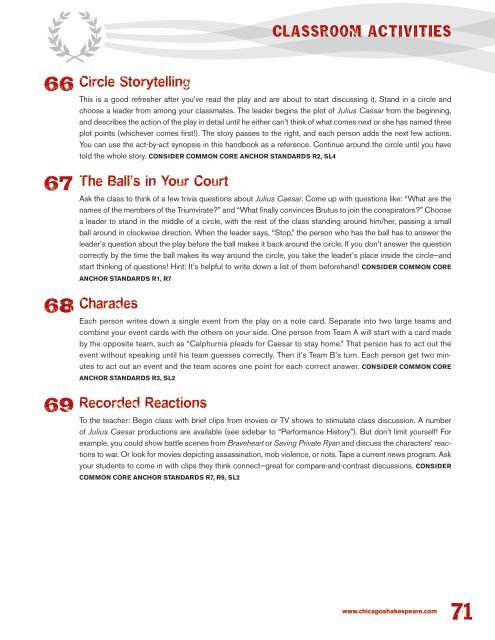Julius Caesar • 2013 - Chicago Shakespeare Theater
Julius Caesar • 2013 - Chicago Shakespeare Theater
Julius Caesar • 2013 - Chicago Shakespeare Theater
Create successful ePaper yourself
Turn your PDF publications into a flip-book with our unique Google optimized e-Paper software.
66<br />
67<br />
Circle Storytelling<br />
CLASSROOM ACTIVITIES<br />
This is a good refresher after you’ve read the play and are about to start discussing it. Stand in a circle and<br />
choose a leader from among your classmates. The leader begins the plot of <strong>Julius</strong> <strong>Caesar</strong> from the beginning,<br />
and describes the action of the play in detail until he either can’t think of what comes next or she has named three<br />
plot points (whichever comes first!). The story passes to the right, and each person adds the next few actions.<br />
You can use the act-by-act synopsis in this handbook as a reference. Continue around the circle until you have<br />
told the whole story. CONSIDER COMMON CORE ANCHOR STANDARDS R2, SL4<br />
The Ball’s in Your Court<br />
Ask the class to think of a few trivia questions about <strong>Julius</strong> <strong>Caesar</strong>. Come up with questions like: “What are the<br />
names of the members of the Triumvirate?” and “What finally convinces Brutus to join the conspirators?” Choose<br />
a leader to stand in the middle of a circle, with the rest of the class standing around him/her, passing a small<br />
ball around in clockwise direction. When the leader says, “Stop,” the person who has the ball has to answer the<br />
leader’s question about the play before the ball makes it back around the circle. If you don’t answer the question<br />
correctly by the time the ball makes its way around the circle, you take the leader’s place inside the circle—and<br />
start thinking of questions! Hint: It’s helpful to write down a list of them beforehand! CONSIDER COMMON CORE<br />
ANCHOR STANDARDS R1, R7<br />
68 Charades<br />
Each person writes down a single event from the play on a note card. Separate into two large teams and<br />
combine your event cards with the others on your side. One person from Team A will start with a card made<br />
by the opposite team, such as “Calphurnia pleads for <strong>Caesar</strong> to stay home.” That person has to act out the<br />
event without speaking until his team guesses correctly. Then it’s Team B’s turn. Each person get two minutes<br />
to act out an event and the team scores one point for each correct answer. CONSIDER COMMON CORE<br />
ANCHOR STANDARDS R3, SL2<br />
69<br />
Recorded Reactions<br />
To the teacher: Begin class with brief clips from movies or TV shows to stimulate class discussion. A number<br />
of <strong>Julius</strong> <strong>Caesar</strong> productions are available (see sidebar to “Performance History”). But don’t limit yourself! For<br />
example, you could show battle scenes from Braveheart or Saving Private Ryan and discuss the characters’ reactions<br />
to war. Or look for movies depicting assassination, mob violence, or riots. Tape a current news program. Ask<br />
your students to come in with clips they think connect—great for compare-and-contrast discussions. CONSIDER<br />
COMMON CORE ANCHOR STANDARDS R7, R9, SL2<br />
www chicagoshakespeare com 71




